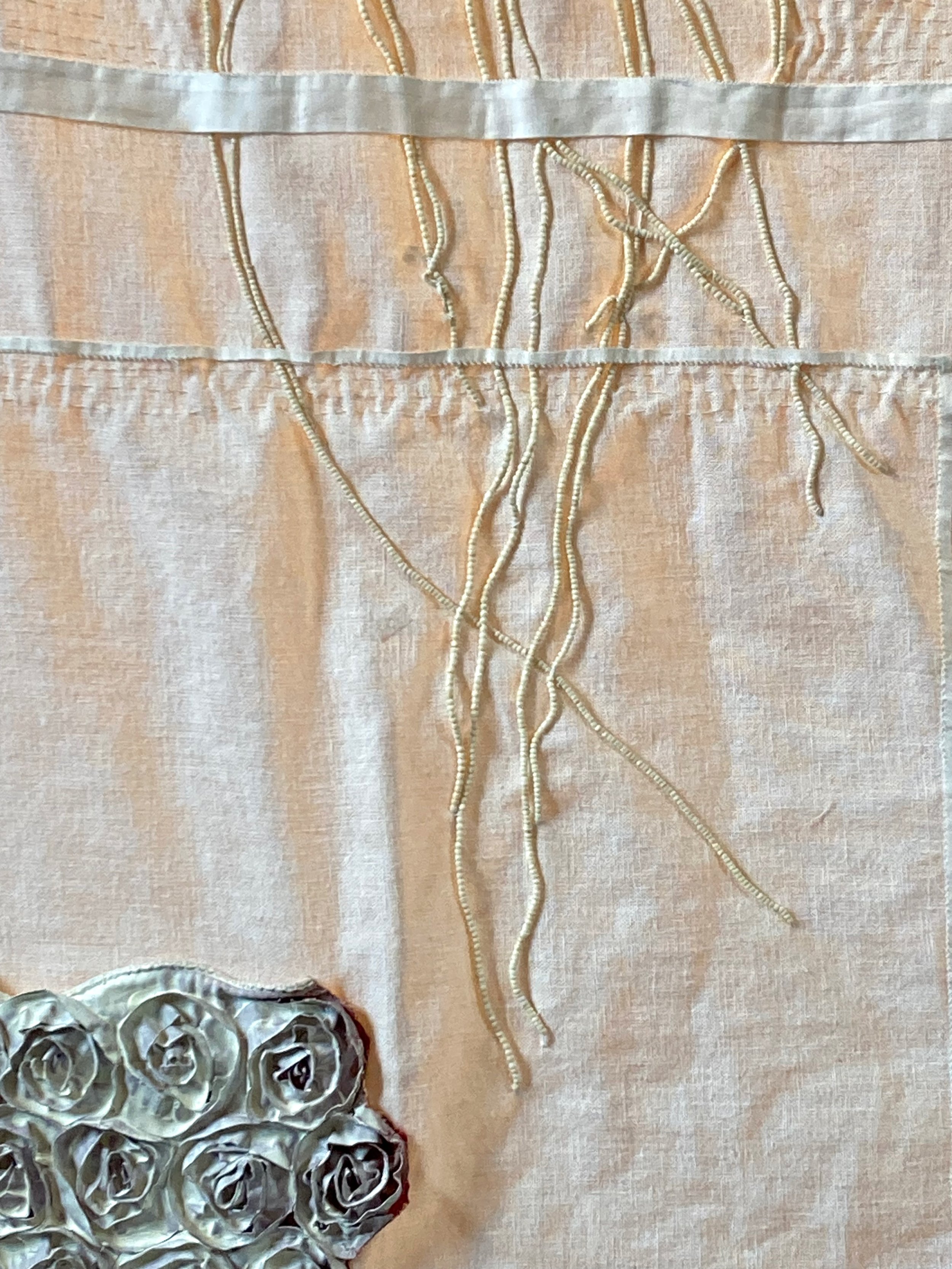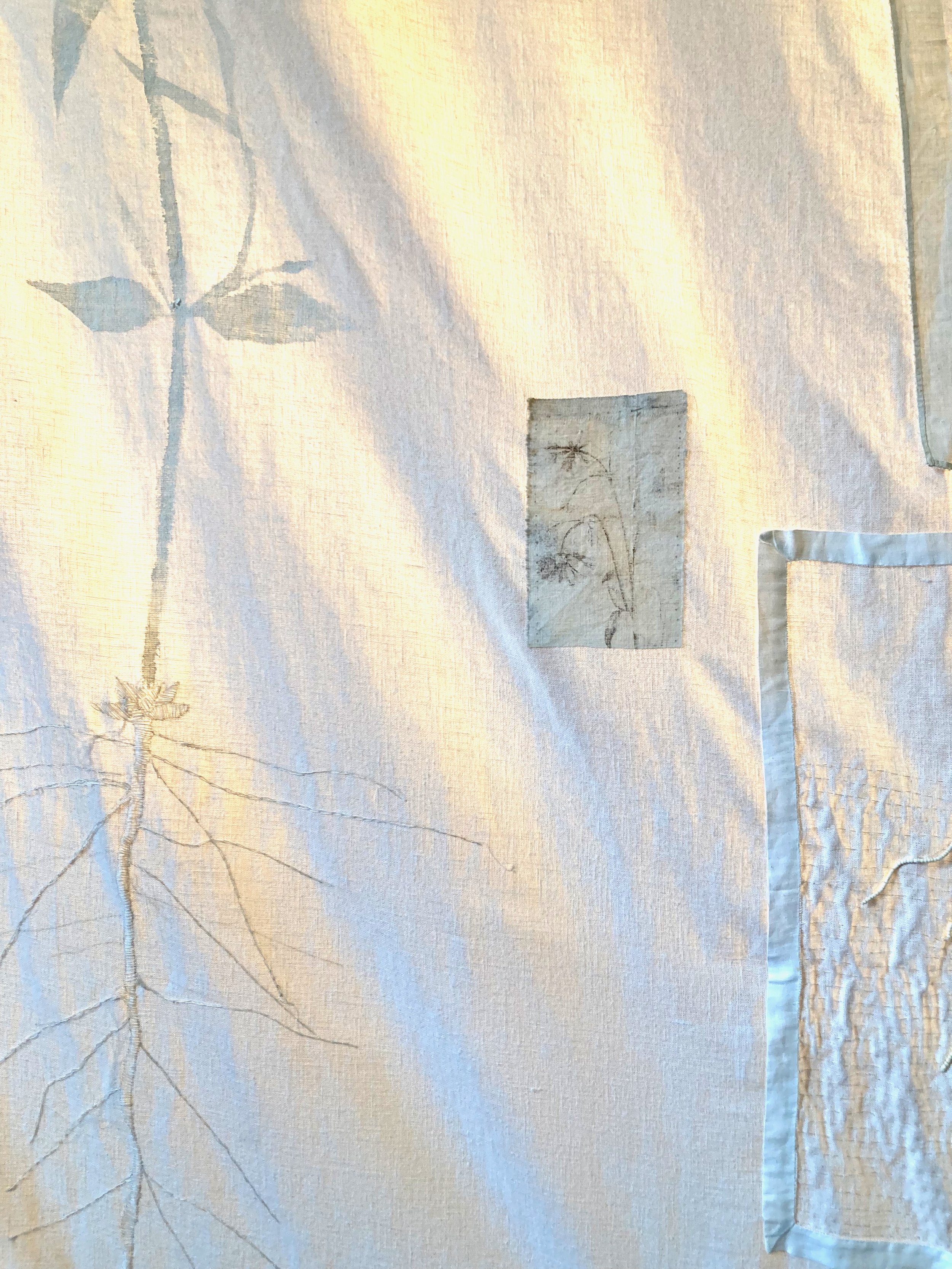Sarah Jones: SWATHS
“The time was introspective and brooding in a way that sometimes we need to be in order to dig deep and become rapt in our process.”
Fall 2023 Artist-in-Residence at Flathead Lake Biological Station
Detail of Sarah’s work
Tell us about your artistic background.
I was raised in Utah as a "red diaper" baby. (My parents were political activists.) My father is an acclaimed Western landscape painter. My brothers and I grew up sketching and painting and stomping through the incredible landscapes that my father was drawn to paint, including Montana. Initially, I was a dance major in college, but I eventually switched to visual art, studying painting and printmaking. It was not until I got to graduate school that my work became installational. I earned my MFA from the School of Visual Art in NYC. After graduate school, I moved to Northern Arizona, where I had been working summers as a Grand Canyon river guide. I continued to guide and taught at Northern Arizona University and Prescott College. My art-making was put on hold upon becoming a mother. Seattle became my home in 2002. I eventually returned to the studio after a ten-year hiatus. This is when my medium became textile-based. I was awarded several residencies once I began to make work again and began consistently showing my work.
Sewing table at Flathead Lake Biological Station
How was your experience as an Open AIR Artist-in-Residence?
My Open AIR Artist Residency at FLBS was a long and deep fall into Autumn in NW Montana. It was deeply ruminative, quiet, poignant, productive, sometimes lonely, sometimes companionable and piercingly beautiful. I was able to set up an effective studio in the second room of my cabin and installed work in progress in the wooded areas around my cabin. The white fabrics glowed against the autumn colors. It was a pleasure to be able to spend hours exploring the herbarium housed at the site. The water played a significant role. Regularly, I paddle-boarded and swam in the lake; the light and sound upon the water were a constant companion. My stone-skipping technique improved significantly. Occasionally, some of the residents would meet on the beach in the gloaming to skip stones and break the solitude of the day.
I spent my time in residency starting a new large-scale piece, finishing some work started earlier in the summer, and writing. The work that I completed while at FLBS was included in a solo exhibit that opened mid-way through the residency at Love Child Gallery in Missoula, MT.
In retrospect, it felt like I was in a reverie while at FLBS. The time was introspective and brooding in a way that sometimes we need to be in order to dig deep and become rapt in our process.
View from the paddle board
Textile piece in the landscape
Tell us about your most recent solo exhibition.
My most recent solo exhibition happened while I was in residence. It was at Love Child Gallery in Missoula, MT. This gallery was the brainchild of the graduate students I had worked with at the University of Montana. It is a non-profit, student-run gallery. It is a breath of fresh air in the Missoula art scene. It was such a blessing and a privilege to exhibit in the sweet little gallery. Usually, my work is shown in lofty spaces with high ceilings and lots of natural light. Love Child is in a basement space, and there is almost no natural light. Much to my surprise and relief, this space was strangely perfect for my work. There was an intimacy and an "under-groundedness" that lent significance to my idea of the creative necessity of sowing/sewing in the dark.
Detail of Sarah’s work
What was your research process during your residency?
My research process revolved around long hours of needleworking swaths of the larger fabric pieces, often inspired by observations made while studying the on-site herbarium. I read poetry and wrote my dreams down. I sketched, took botanical notes, and worked on my plant identification while roaming the local terrain and hiking the trails.
Full wetsuit swimming at Flathead Lake, Polson, MT
What are you up to now (post Open AIR)?
It was a gift to be able to spend my last month in Montana as an Open AIR Resident at FLBS, having just finished a three-year stint teaching in the Visual and Media Arts Department at the University of Montana. I am back in Seattle now, in my home, setting the studio up and getting back into the groove of life here in the Pacific Northwest. I continue to work on themes of loss and grief in the face of climate collapse. I am thinking about "unraveling whiteness" literally and metaphorically in order to explore themes of race and the role of "whiteness" in the climate crises.
Detail of Sarah’s work
Like to know more about Sarah? Visit her website and follow her on Instagram @sarah_jones_studio









